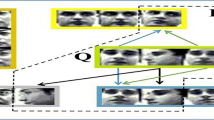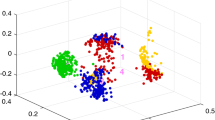Abstract
Image set classification has drawn much attention due to its rich set information. Recently, the most popular set-to-set distance-based representation methods have achieved interesting results by measuring the between-set distance. However, there are two intuitive assumptions, which are largely ignored: (1) The homogeneous samples should have positive contributions to approximate the nearest point in the probe set, while the heterogeneous samples should have no contributions and (2) the learned nearest points in each gallery set should have the lowest correlations. Therefore, this paper presents a novel method called nonnegative discriminative encoded nearest points for image set classification. Specifically, we use two explicit nonnegative constraints to ensure the coding coefficients sparse and discriminative simultaneously. Moreover, we additionally introduce a new class-wise discriminative term to further boost the discriminant ability of different sets. In this way, they can be boosted mutually so that the obtained coding coefficients are beneficial to the purpose of set classification. The results from extensive experiments and comparisons with some state-of-the-art methods on four challenging datasets demonstrate the superiority of our method.







Similar content being viewed by others
References
Chen Z, Jiang B, Tang J, Luo B (2017) Image set representation and classification with attributed covariate-relation graph model and graph sparse representation classification. Neurocomputing 226:262–268
Zhu P, Zuo W, Zhang L, Shiu SCK, Zhang D (2014) Image set-based collaborative representation for face recognition. IEEE Trans Inf Forensics Secur 9(7):1120–1132
Shao M, Tang D, Liu Y, Kim TK (2016) A comparative study of video-based object recognition from an egocentric viewpoint. Neurocomputing 171:982–990
Moon HM, Seo CH, Pan SB (2017) A face recognition system based on convolution neural network using multiple distance face. Soft Comput 21(17):4995–5002
Wang G, Shi N (2019) Collaborative representation-based discriminant neighborhood projections for face recognition. Neural Comput Appl. https://doi.org/10.1007/s00521-019-04055-6
Chen L, Hassanpour N (2017) Survey: How good are the current advances in image set based face identification? Experiments on three popular benchmarks with a naïve approach. Comput Vis Image Underst 160:1–23
Ren Z, Wu B, Sun Q, Wu M (2019) Simultaneous learning of reduced prototypes and local metric for image set classification. Expert Syst Appl 134:102–111
Wright J, Yang AY, Ganesh A, Sastry SS, Ma Y (2009) Robust face recognition via sparse representation. IEEE Trans Pattern Anal Mach Intell 31(2):210–227
Xu J, An W, Zhang L, Zhang D (2019) Sparse, collaborative, or nonnegative representation: which helps pattern classification? Pattern Recognit 88:679–688
Tang D, Zhu N, Yu F, Chen W, Tang T (2014) A novel sparse representation method based on virtual samples for face recognition. Neural Comput Appl 24(3–4):513–519
Zeng S, Gou J, Yang X (2018) Improving sparsity of coefficients for robust sparse and collaborative representation-based image classification. Neural Comput Appl 30(10):2965–2978
Zhang H, Wang S, Xu X, Chow TW, Wu QJ (2018) Tree2vector: learning a vectorial representation for tree-structured data. IEEE Trans Neural Netw Learn Syst 99:1–15
Hua J, Wang H, Ren M, Huang H (2017) Collaborative representation analysis methods for feature extraction. Neural Comput Appl 28(1):225–231
Cevikalp H, Triggs B (2010) Face recognition based on image sets. In: IEEE computer society conference on computer vision and pattern recognition. IEEE, pp 2567–2573
Yang M, Zhu P, Van Gool L, Zhang L (2013) Face recognition based on regularized nearest points between image sets. In: 10th IEEE international conference and workshops on automatic face and gesture recognition (FG). IEEE, pp 1–7
Kim TK, Kittler J, Cipolla R (2007) Discriminative learning and recognition of image set classes using canonical correlations. IEEE Trans Pattern Anal Mach Intell 29(6):1005–1018
Wang R, Shan S, Chen X, Gao W (2008) Manifold-manifold distance with application to face recognition based on image set. In: IEEE conference on computer vision and pattern recognition, CVPR 2008. IEEE, pp 1–8
Hamm J, Lee DD (2008) Grassmann discriminant analysis: a unifying view on subspace-based learning. In: Proceedings of the 25th international conference on machine learning. ACM, pp 376–383
Hu Y, Mian AS, Owens R (2012) Face recognition using sparse approximated nearest points between image sets. IEEE Trans Pattern Anal Mach Intell 34(10):1992–2004
Ren Z, Wu B, Zhang X, Sun Q (2019) Image set classification using candidate sets selection and improved reverse training. Neurocomputing 341:60–69
Feng Q, Zhou Y, Lan R (2016) Pairwise linear regression classification for image set retrieval. In: Proceedings of the IEEE conference on computer vision and pattern recognition, pp 4865–4872
Wang W, Wang R, Shan S, Chen X (2017) Prototype discriminative learning for image set classification. IEEE Signal Process Lett 24(9):1318–1322
Wang W, Wang R, Shan S, Chen X (2015) Probabilistic nearest neighbor search for robust classification of face image sets. In: 11th IEEE international conference and workshops on automatic face and gesture recognition (FG), vol 1. IEEE, pp 1–7
Shah SA, Nadeem U, Bennamoun M, Sohel F, Togneri R (2017) Efficient image set classification using linear regression based image reconstruction. In: Proceedings of the IEEE conference on computer vision and pattern recognition workshops, pp 99–108
Song Z, Cui K, Cheng G (2019) Image set face recognition based on extended low rank recovery and collaborative representation. Int J Mach Learn Cybern. https://doi.org/10.1007/s13042-019-00941-6
Shah SAA, Bennamoun M, Boussaid F (2016) Iterative deep learning for image set based face and object recognition. Neurocomputing 174:866–874
Hayat M, Bennamoun M, An S (2015) Deep reconstruction models for image set classification. IEEE Trans Pattern Anal Mach Intell 37(4):713–727
Uzair M, Shafait F, Ghanem B, Mian A (2018) Representation learning with deep extreme learning machines for efficient image set classification. Neural Comput Appl 30(4):1211–1223
Yang M, Wang X, Liu W, Shen L (2017) Joint regularized nearest points for image set based face recognition. Image Vis Comput 58:47–60
Shao J, Huang F, Yang Q, Luo G (2018) Robust prototype-based learning on data streams. IEEE Trans Knowl Data Eng 30(5):978–991
Liu W, Xu D, Tsang IW, Zhang W (2019) Metric learning for multi-output tasks. IEEE Trans Pattern Anal Mach Intell 41(2):408–422
Leng M, Moutafis P, Kakadiaris IA (2015) Joint prototype and metric learning for set-to-set matching: application to biometrics. In: IEEE 7th international conference on biometrics theory, applications and systems (BTAS). IEEE, pp 1–8
Xu Y, Li Z, Yang J, Zhang D (2017) A survey of dictionary learning algorithms for face recognition. IEEE Access 5:8502–8514
Yang M, Zhang L, Yang J, Zhang D (2010) Metaface learning for sparse representation based face recognition. In: 2010 IEEE international conference on image processing. IEEE, pp 1601–1604
Acknowledgements
We would like to thank Pengfei Zhu, who shared the source code of RH-ISCRC on their homepage, and to thank Meng Yang, who shared the RNP code. We would also like to thank all the anonymous reviewers who provided substantive suggestions for improving our work.
Funding
This research was supported by the National Natural Science Foundation of China (Grant No. 61673220), the Department of Science and Technology of Sichuan Province (No. ZYF-2018-106), the Sichuan Province Science and Technology Support Program (No. 2018TZDZX0002), and the State Administration for Science, Technology and Industry for National Defense (Nos. JCKY2017209B010 and JCKY2018209B001).
Author information
Authors and Affiliations
Corresponding authors
Ethics declarations
Conflict of interest
The authors declare that they have no conflict of interest.
Additional information
Publisher's Note
Springer Nature remains neutral with regard to jurisdictional claims in published maps and institutional affiliations.
Rights and permissions
About this article
Cite this article
Ren, Z., Sun, Q. & Yang, C. Nonnegative discriminative encoded nearest points for image set classification. Neural Comput & Applic 32, 9081–9092 (2020). https://doi.org/10.1007/s00521-019-04419-y
Received:
Accepted:
Published:
Issue Date:
DOI: https://doi.org/10.1007/s00521-019-04419-y




